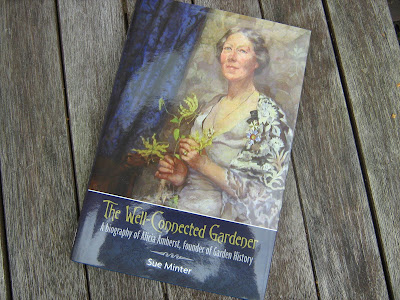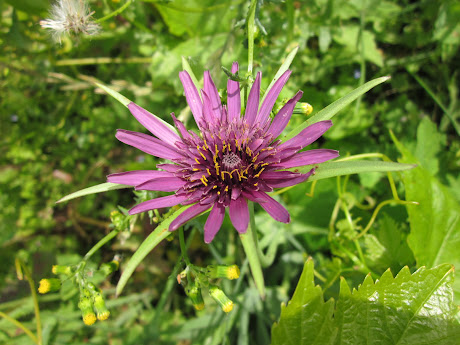The Well-Connected Gardener

Today it's hard to believe that garden history hasn't always been here. After all we know our garden heritage goes back many centuries, even if a lot of it has been swept away by subsequent fashions or ideas. That's why it came as a surprise to me when I first picked up The Well-Connected Gardener to find its study is only a century or so old.
Another surprise is that the distinguished career of Alicia Amherst (aka The Well-Connected Gardener) seems to have been almost forgotten. She was a contemporary of Gertrude Jekyll and a friend of Ellen Willmott (of Miss Willmott's Ghost fame), and for many years was a member of the management committee of Chelsea Physic Garden. She was the author of several seminal works and was active in ensuring that horticultural training was opened up for women. This was quite controversial at the time because women started to take on the role of head gardeners on major estates, although her main motivation was ensuring people with the right skills went abroad to help colonise the empire.
This book gives a fascinating glimpse of a time and a world long since gone. Alicia Amherst may have been a well educated member of the aristocracy who then became heavily involved in political matters, but it's clear she used her privileged background to help others. During the First World War she was heavily involved in ensuring the security of the nation's food supplies: pioneering work which paved the way for the Dig for Victory campaign during the Second World War. I expected her to be a suffragette, but actually she openly opposed the movement, preferring instead to find more pragmatic ways (mainly through education) to elevate the role of women in society.
Alicia Amherst was born in 1865 into an extremely wealthy family, whose country estate was a mere 1,500 acres in Didlington, Norfolk. Perhaps more importantly for us, her father collected antiquarian manuscripts and books and was acknowledged as having one of the finest libraries in the country. It was noted for its works on the history of printing and Egyptology, but also contained early manuscripts on gardening.
As well as the library, Alicia was also introduced to gardening at an early age, so perhaps it's no great surprise she combined both loves by writing A History of Gardening in England, published in 1895 when she was 30. It's an objective, scholarly work which set gardening history alongside social, political and technological changes. It's also said to be very readable. It seems her objectivity lead to some criticism concerning her own lack of critique e.g for not raising the issue of how the landscape movement swept away many earlier gardens. She was also scorned by some for not focusing on the architectural aspects of garden design, whilst others took her to task for not doing the same with plants. Some things never change!
Alicia's other pioneering works were: London Parks and Gardens (1907 and perhaps one of the earliest looks at public planting); Historic Gardens of England (1938); and Wild Flowers of the Dominions of the British Empire (1935 and where she demonstrated knowledge not only of the economic value of plants but also aspects of ecology and ethnobotany). She was also honoured for her charitable and horticultural work (both CBE and DBE), but perhaps the honour she valued most highly was being given the freedom of the Worshipful Company of Gardeners in 1896, the first woman to be honoured in such a way.
Sue Minter has used Chelsea Physic Garden's and other archive sources well: she allows her subject to tell her own story wherever possible though her letters, papers and artistic endeavours in such a way that I often forgot I was reading a biography. Personally I would have liked more details on the contents of each of Alicia's books - and there is room in this relatively slim volume and scholarly work for her to have done so - but there's sufficient there for me to hope I find them on one of my regular second hand bookshop forays. However, her life was much more than gardening or garden history and I prefer to be introduced to the whole person rather than just one aspect.
If this sounds like your kind of book, then you can win my review copy by leaving a comment here on my blog by midnight on 13th December. Sorry, this is only available to UK based readers. I'll let you know who's won on the 14th, which also means I should get it to you in time for Christmas :)
Update: I've just found out a copy of A History of Gardening in England is available to read online via the Open Library organisation.










Really enjoyed your review, this sounds like a book I would enjoy, those old girls really laid the trail for us!
ReplyDeleteOh I kind of wish I lived in those days. All those challenges to rise to, all those 'firsts' to achieve. You can't help feeling we're all a little jaded today by comparison.
ReplyDeleteSounds like a fantastic book and thanks for the review! And also for the chance to fulfil (for once) a promise to you to enter one of your giveaways :D
Glad you've found a first-hand source. It was frustrating reading the review of her biography without knowing what you think of her writing yourself. Next episode?
ReplyDeleteEsther
P.S. Don't put me in the draw. With all the will in the world I would only read it out of duty whereas many of your other readers would read it with interest and delight.
Oh hoorah, I'm in time to join your draw...
ReplyDeleteShe sounds fascinating, will add it to my Christmas list if I don't hear from you first:-)
EmmaB - yes. I often wonder if I would have been brave enough to be a suffragette. I suspect I would have been one of the women beetling away at finding the pragmatic smaller steps to help elevate the status of women
ReplyDeleteCG - I was the first in my family to attend Uni and it's down to these trailblazers that I had the opportunity :)
Esther - I'm so glad I found that link. Like you I was frustrated in not being able to read any of her books. I'd love to find the others too.
Scattered Gardener - good luck! How's the singing going? We'll be doing another regional Sing for Water in 2011
What a fascinating woman! It is so easy to take it for granted that as women we have the same rights to education, including horticultural training, as any man. Not sure I like the colonial side of it, but hey, it is part of our history, and of her context. She may have opposed the suffragettes, but she clearly played her part in the freedoms we now enjoy. I am ashamed to say I have never read a biography of a gardener, in fact I rarely read biographies at all, except of climbers and sailors I admire. I'm starting to wonder why.
ReplyDeleteReally enjoyed your review of this book and finding out more about a name I knew, but that was all!
ReplyDeleteActually I also used to grow a Hebe called Alicia Amsherst-large leaved, rich purple flowers and quite tender-it may still be in the family garden in Devon-I wonder if there is a connection. Always interesting to find out why things are named as they are.You will have your own favourite second hand book sources, but
Ardens in Hay might be good source for more of her work.
Best Wishes
Robert
This comment has been removed by the author.
ReplyDeleteJanet - I wasn't sure about the colonial aspect either at first, but then recognised that times were very different back then. Shh! it was my first gardening biography too, so I didn't know what to expect. I'm glad I had the opportunity to broaden my reading and I'll be seeking out more.
ReplyDeleteRobert - the only plant mentioned in the book as being named after her is Haemanthus cecilae which is a blood liliy and refers to her married name. There's also Amherstia nobilis a tree of the pea family, though it's not clear in the book which Amherst family member it was named for - Alicia's father perhaps. However, that doesn't mean your Hebe is connected in some way, an interesting little piece of research to ponder...
On her travels in South Africa she found 40 new species and hoped the yellow form of the Gloriosa lily she'd found would be named after her, but Kew decided differently.